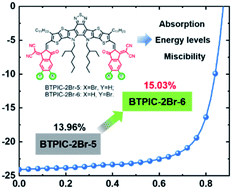The regioisomeric bromination effects of fused-ring electron acceptors: modulation of the optoelectronic property and miscibility endowing the polymer solar cells with 15% efficiency†
Abstract
Minimizing the trade-off between JSC and VOC has been identified as a critical strategy for optimizing the device performance with the advance of polymer solar cells (PSCs). Here, two regioisomerically brominated fused-ring electron acceptors, namely BTPIC-2Br-5 and BTPIC-2Br-6, were synthesized and the effects of the bromination position on the basic optoelectronic properties, physiochemical properties, charge transport properties, BHJ morphologies, and the photovoltaic performance were investigated. It was found that BTPIC-2Br-6, which had one bromine substitution at the 6-position, showed a narrower absorption, upshifted highest occupied molecular orbital (HOMO), and downshifted lowest unoccupied molecular orbital (LUMO) energy levels in comparison with BTPIC-2Br-5. Such a minute variation provides an opportunity for fine-tuning the VOC–JSC trade-off for a better solar cell. The results showed that the BTPIC-2Br-6-based device realized a very high PCE of over 15% because the higher JSC and FF compensated for the VOC decline. The detailed morphology study revealed that the BTPIC-2Br-6-based blend film had a better phase separation, which mainly resulted in a more balanced charge transport and weaker trap-assisted recombination in the device. The interaction parameter determination for the material combinations further manifested that BTPIC-2Br-6 tends to easily form an intermixed morphology, which established a material structure–morphology relationship. This study underlines the regioisomeric bromination effect of FREAs on the material optoelectronic properties and miscibility, thereby optimizing the photovoltaic efficiency.

- This article is part of the themed collection: Journal of Materials Chemistry A HOT Papers


 Please wait while we load your content...
Please wait while we load your content...